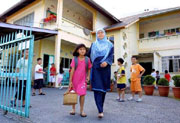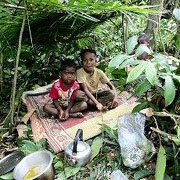-
(单词翻译:双击或拖选)
Pilot Program Teaches Sarawak Indigenous1 Children in Mother Tongue
Sarawak is one of two Malaysian states on the island of Borneo. It is home to 28 ethnic2 groups, each with a distinct language, culture and lifestyle. Many groups are afraid of losing their traditional ways, as modern life encroaches. An indigenous farming community in a remote part of Sarawak is teaching pre-school children in their mother tongue, instead of in the dominant3 Malay language.
Natural learners
Dozens of three- and four-year-olds enthusiastically surround a group of visitors. They are not in the least bit shy of the strangers. They are curious and engage the visitors in animated4 chatter5. An official says the children are always this rambunctious6.
“They are just as themselves. They are not putting on a show. When I come over here once a month or even twice a month, they will be doing the same thing. That is what we want to teach them, to be confident. They have a lot of interactions with the teachers, you know,” said Josak Anak Siam, the coordinator7 for the Multilingual Education Program in Kampung Bunuk, a small farming community in this remote part of Sarawak. He helped set up the pre-school, which conducts lessons in the native Bidayuh language.
Pilot program
 |
| A Malaysian mother picks her daughter up from a pre-school after it was closed in Kuching, the capital of Malaysia's Borneo state of Sarawak. (File Photo) |
The community pilot program began in January 2007, in association with the United Nations Educational, Scientific and Cultural Organization and the Malaysian branch of the Summer Institute of Linguistics8.
Josak says the village launched the pre-school program after receiving a briefing by SIL officials on the benefits of multilingual education.
“That is the time when SIL officers explained to us that many languages are dying off because the people are not taking an initiative to preserve the languages," Josak said. "So, before the Bidayuh language dies off in this world, we have to take this action to develop the curriculum and then we start off with the play schools where we intend to let the children have a strong foundation in their mother tongue before they learn other languages.”
Changing lifestyles
It is becoming more difficult to keep indigenous languages alive as many of the communities in which they are spoken are at risk of vanishing.
 |
| Children from the Batek tribe play in the jungle near their village next to the entrance of Kuala Koh National Park in the northeastern Peninsular Malaysia state of Kelantan. (File Photo) |
Siti Rodziah, senior manager in Sididik’s Business Development and Financial Division, notes only about 2,000 people live in Kampung Bunuk. She says young people are leaving the village and migrating to Sarawak’s administrative9 capital, Kuching, and other cities in search of work. The old people are left behind to do the farming, she says.
“Now, when their children start to grow up nowadays, they are more educated and they have a better job in a big town or cities," she said. "This is why now, you can see, the numbers are getting lower in the village compared to in the city. My hope for my state here is we still preserve whatever natural culture that we have for all ethnics10.”
UNICEF
The U.N. Children’s Fund is supporting several maternal-language pre-school programs among the ethnic-Hmong people in Vietnam.
UNICEF’s deputy representative for Malaysia, Victor Karunan, says he is impressed with the results coming out of this three-year project. He believes such programs would be similarly advantageous11 for other children in Malaysia.
“In fact, evidence shows that those children who actually began their initial learning in pre-school and in early primary in their mother tongue have actually performed much better, even if they have had to switch languages, later on," Karunan said. "That is what evidence has shown and that is why in different countries UNICEF has supported what we call mother-tongue-based bilingual education.”
Classroom
Back in Kampung Bunuk, the teacher begins the day’s lesson with a prayer. This is intended to develop the spiritual values of the children in this Christian12 community. The rest of the three-and-a-half-hour session is given over to simple reading and math, art and playtime.
When the children reach age six, they go through a so-called bridging year, in which they are taught in both the indigenous and Malay languages. When they enter primary school, at age seven, lessons are conducted in Malay. English is gradually introduced. Officials here believe the children maneuver13 this transition very well.
The community remains14 enthusiastic about the program, but is afraid it may have to close the pre-school for lack of funds. UNESCO stopped financing the project last year, saying it wants to support similar programs in other countries. Kampung Bunuk is hoping the government and private sources will come up with the money they need to keep the program alive.
 收听单词发音
收听单词发音
1
indigenous

|
|
| adj.土产的,土生土长的,本地的 | |
参考例句: |
|
|
|
2
ethnic

|
|
| adj.人种的,种族的,异教徒的 | |
参考例句: |
|
|
|
3
dominant

|
|
| adj.支配的,统治的;占优势的;显性的;n.主因,要素,主要的人(或物);显性基因 | |
参考例句: |
|
|
|
4
animated

|
|
| adj.生气勃勃的,活跃的,愉快的 | |
参考例句: |
|
|
|
5
chatter

|
|
| vi./n.喋喋不休;短促尖叫;(牙齿)打战 | |
参考例句: |
|
|
|
6
rambunctious

|
|
| adj.喧闹的;粗鲁的 | |
参考例句: |
|
|
|
7
coordinator

|
|
| n.协调人 | |
参考例句: |
|
|
|
8
linguistics

|
|
| n.语言学 | |
参考例句: |
|
|
|
9
administrative

|
|
| adj.行政的,管理的 | |
参考例句: |
|
|
|
10
ethnics

|
|
| n.伦理学,人种学 | |
参考例句: |
|
|
|
11
advantageous

|
|
| adj.有利的;有帮助的 | |
参考例句: |
|
|
|
12
Christian

|
|
| adj.基督教徒的;n.基督教徒 | |
参考例句: |
|
|
|
13
maneuver

|
|
| n.策略[pl.]演习;v.(巧妙)控制;用策略 | |
参考例句: |
|
|
|
14
remains

|
|
| n.剩余物,残留物;遗体,遗迹 | |
参考例句: |
|
|
|















